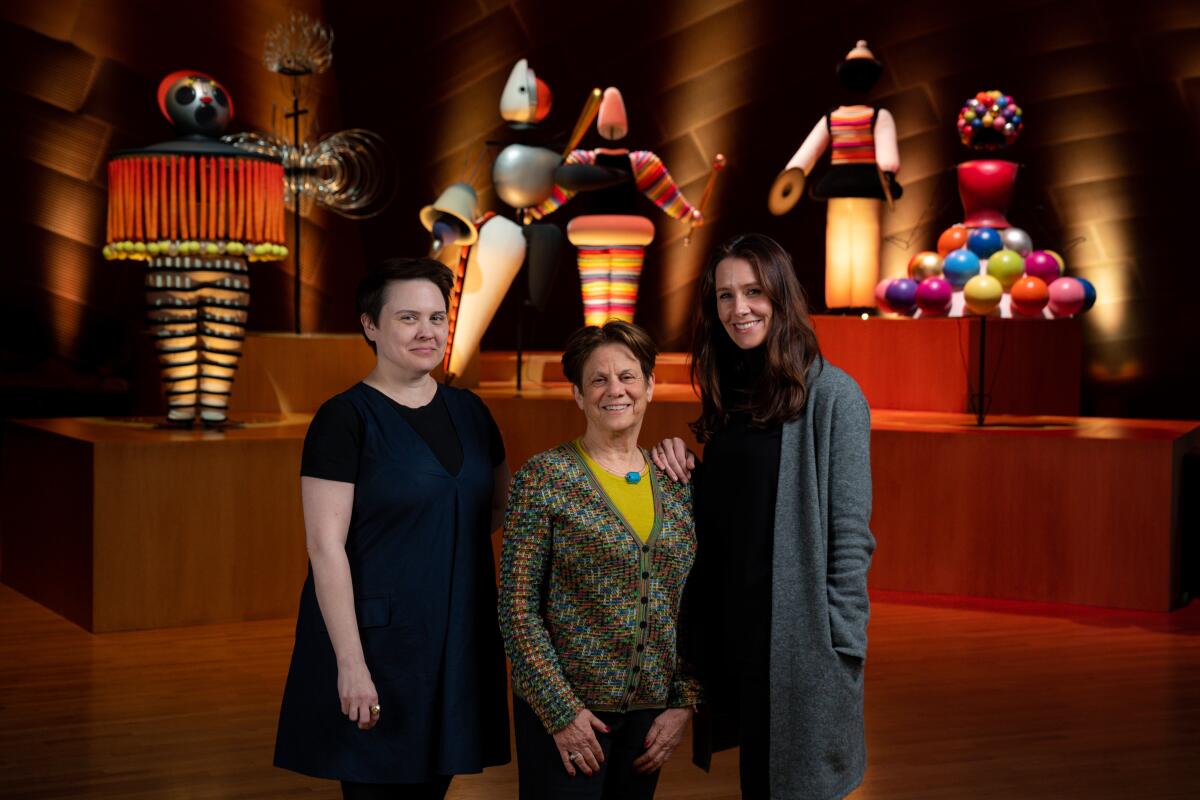L.A. Phil’s Weimar festival looks at the art of a bygone yet familiar era

- Share via
The figurines, sculpted by Oskar Schlemmer for his 1922 Triadic Ballet, have taken up residence in a cavernous antechamber inside Walt Disney Concert Hall. The staggered wooden pedestals on which they stand, like the deconstructivist building they occupy, were designed by architect Frank Gehry.
The artist and the architect belong to different generations but share the experimental aesthetic of the Weimar era, the renaissance of art, architecture, culture and sexuality that flourished in Germany after the First World War, ending in 1933 with the precipitous rise of the Nazis.
This fascinating period of history is being examined by the Los Angeles Philharmonic in a festival titled “Weimar Republic: Germany 1918-1933,” which started Thursday and runs through Feb. 29.
The display of Schlemmer’s creations, which began life as elaborate structural costumes worn by performers in what has long been considered a masterpiece of avant-garde dance, is a component of “Weimar Variations,” a project curated by Stephanie Barron, head of the modern art department at Los Angeles County Museum of Art, and Nana Bahlmann, an independent curator and writer who splits her time between Berlin and L.A.
“Weimar Variations” augments conductor Esa-Pekka Salonen’s musical exploration of the era with a series of free and ticketed public programs in unexpected locations, including a worker’s chorus and march; a cabaret; a film marathon that will screen the first gay-themed film ever made; a sound installation by Berlin-based artist Susan Philipsz, featuring a 1926 Hanns Eisler composition; a laser light installation by artist Nicole Miller; a performance piece featuring the sound poetry of Kurt Schwitters; and a photography exhibit of the pioneering work of August Sander, known for his candid documentary photography of the changing times and mores.
Several days before the launch of the festival, Barron and Bahlmann watch as preparators, guided by Schlemmer’s grandson, Raman Schlemmer, install the figurines. The pieces are supported by graceful black armatures made by Raman’s mother, who was as a stage and costume designer. The sun pours through a skylight, imbuing the delicate sculptures —made of papier-mâché, glass, fabric, wood and all manner of found objects — with a playful, lifelike essence.
“It’s kind of like ‘The Nutcracker’ where they perform at night by themselves,” Barron says. “They’re having such a good time in this space.”
Raman Schlemmer nods, smiling.
“Sometimes I come back and the head has changed into a different direction and I say, ‘Oh you were dancing again,’” he says.
The figurines, which have not been seen in the U.S. in 30 years, will be on display throughout the festival. They can be viewed in an entirely fresh context Saturday night when Miller stages her laser light installation on the vaulted wooden wall behind them.
Miller’s commissioned piece is inspired by Schlemmer’s colleague and fellow Bauhaus artist Wassily Kandinsky, who is often credited as the pioneer of abstract art and is known for his radical approach to color theory and his belief in synesthesia. Miller creates her own ode to the harmony of language, color and form by using synthesizers to help translate laser images into shapes, words and hues.
Experimentation was key to the Weimar era, and Barron and Bahlmann say they did their best to incorporate the period’s spirit into every offering. The L.A. Phil’s humanities director, Julia Ward, who helped to organize the festival, was tasked with connecting curators to contributing artists and creators.
The idea for a Weimar festival grew from Salonen’s interest in the era’s aesthetic — its artistic freedom in blending art forms and genres. He also wanted to examine how aspects of Weimar history have particular resonance in modern times.
“Eras of rationality, optimism and growth can give way, quite quickly, to the opposite,” Salonen says. “Progress is not inevitable, and perhaps we are living through something that is very similar to the Weimar Republic without knowing it.”
Ideas of cultural fracture, epistemological dissonance and political upheaval permeate the festival’s programming, which includes two concerts conducted by Salonen featuring music by German composers Kurt Weill and Paul Hindemith.
The three themes the curators sought to weave through the ancillary programming were abstraction, new identities and politics. An interdisciplinary approach was key, Bahlmann says, since the 1920s were famous for that.
“It’s our desire to engage as many people as we can because we think this subject is important,” Ward ways of the diversity of offerings.
History, she says, does not walk a straight line, but rather ebbs and flows with tides of human ambition. The goal of the festival is not to draw direct parallels between Weimar and today, but rather to provoke conversations that reflect on where we’ve been and where we’re going.
Weimar blossomed in the shadow of an approaching nightmare. To look back on it is to acknowledge the fragility of freedom.
“This astonishing flourishing of creativity, of liberation, of pushing boundaries came to an abrupt, grinding halt in 1933,” Barron says.
Examining the “why” of that ending through a modern lens of art, music and performance seems a fitting way to proclaim that history need not repeat.
'Weimar Republic: Germany 1918-1933'
Where: Locations around the city, including Walt Disney Concert Hall
When: Through Feb. 29
Tickets: Varies; many events are free
Info: (323) 850-2000, laphil.com
More to Read
The biggest entertainment stories
Get our big stories about Hollywood, film, television, music, arts, culture and more right in your inbox as soon as they publish.
You may occasionally receive promotional content from the Los Angeles Times.











